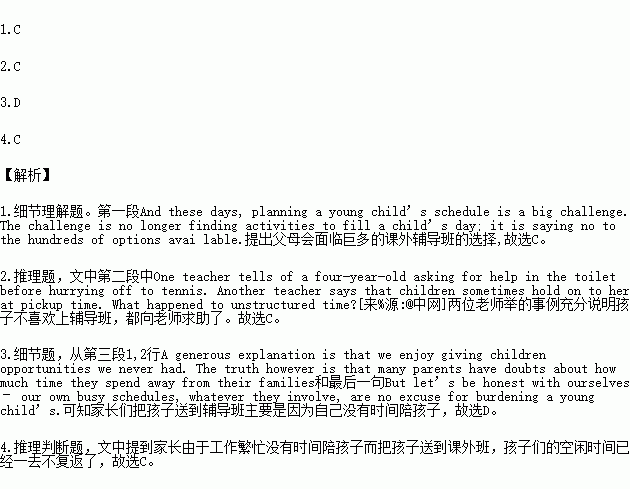题目内容
Dear Mom, Clear My Calendar
September is around the corner, and some of us are already complaining about summer’s end. But parents have a special reason to do so. The end of summer means the start of school. And these days, planning a young child’s schedule is a big challenge. The challenge is no longer finding activities to fill a child’s day; it is saying no to the hundreds of options available. Our mailbox is filled with brochures urging us to sign our kids up for classes from cooking to martial arts(武术).
Educators are themselves discouraged by the number of special classes that many children attend. In the name of “enrichment,” three-year-olds not only go to preschool in the morning but study French or gymnastics after lunch. One teacher tells of a four-year-old asking for help in the toilet before hurrying off to tennis. Another teacher says that children sometimes hold on to her at pickup time. What happened to unstructured time?
A generous explanation is that we enjoy giving children opportunities we never had. The truth however is that many parents have doubts about how much time they spend away from their families. And one way to reduce this guilt is to believe that time spent in these classes is somehow more beneficial to children than the time we know we should be giving them ourselves.
David Elkind, an expert on children, suggests that the 1960s gave birth to the belief that earlier is better. Parents hope that early music lessons, for example will build a child’s confidence. The truth, however, is that any time children are asked to do too much, too soon, they are at greater risk for feelings of failure.
A child’s time does not have to be planned to be meaningful. Remember the lazy days of summer? Some children sleep late and play with the kids across the street until it’s time to come home for dinner. However, with the majority of mothers working, fewer children enjoy that idle (空闲的) time now.
Come September, children across the country will finish a full day of kindergarten, only to attend an after-school program until 6 P.M., when a working mom or dad comes to take them home. That’s too much for a five-year old. Finances, of course, do limit some parents. But let’s be honest with ourselves – our own busy schedules, whatever they involve, are no excuse for burdening a young child’s.
1.The author holds that it’s a challenge to plan a schedule for a child mainly because _____.
A. a child’s schedule is too complex
B. activities suitable for kids are limited
C. parents are stuck in numerous choices
D. children always say no to parents’ advice
2.What the two teachers say in Paragraph 2 implies that _____.
A. children love to stay at school
B. they are popular with children
C. children dislike after-school classes
D. after-school classes are of poor quality
3.According to the author, what is the real reason for parents to send their children to after-school classes?
A. Parents want to make up for their own regrets.
B. After-school classes develop children’s potential.
C. Parents have doubt about their own ability to guide children.
D. After-school classes give parents an excuse for being absent.
4.Which of the following will the author probably agree with?
A. For children’s benefits, the earlier the better.
B. Children’s spare time should be carefully designed.
C. Idle time for children is becoming a thing of the past.
D. Parents should be forgiven if they have a good reason.,

